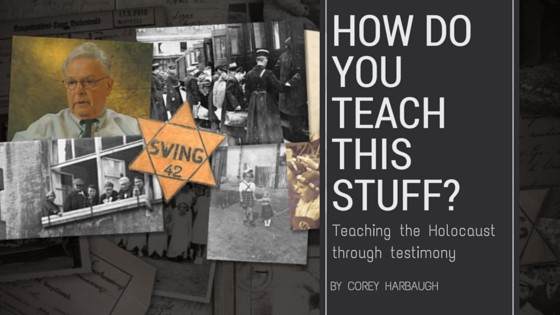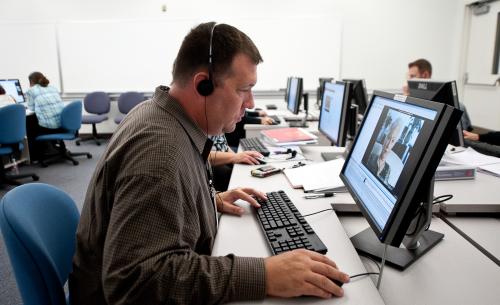How Do You Teach This Stuff?

Two years ago I asked teachers across the United States about the methods and strategies they use to teach the Holocaust in their classrooms. I was conducting this survey as part of my Fellowship work with the United States Holocaust Memorial Museum (USHMM), but I was also doing so as a Master Teacher of USC Shoah Foundation, and a satellite leader for the Memorial Library Holocaust Educator Network.
When it comes right down to it, I was conducting the survey as a classroom teacher doing what good teachers do. Asking colleagues about their teaching practices, so I could get better at teaching myself and share good strategies with others.
The question “How do you teach this stuff?” is what brought me to USC Shoah Foundation in 2010 to begin my training and work as a Master Teacher. I was beginning to understand that survivor testimony is the formative center of Holocaust education, that once a student begins to see Holocaust education content through the lens of testimony, the education and the student begin to change in ways that are profound. I had that experience myself as a student of the Holocaust, and I found that USC Shoah Foundation’s educational website IWitness could and would provide that experience to my students.
IWitness is now helping me engage with my students on one of the most difficult topics in Holocaust education, the role of ordinary citizens in the violence of Kristallnacht in 1938, through the USHMM lesson Some Were Neighbors.
So many times I have been challenged by students and other teachers with the questions of collaboration and complicity during the Holocaust. These are some of the most difficult questions to answer, because the answers are so complex, but USHMM and USC Shoah Foundation have teamed up to help us approach those complex answers through primary sources: the photos, the records, the documents, and the eyewitness accounts of people who were there. In response to these difficult questions, IWitness turns us back, once again towards the human.
 Eventually my survey reached more than 1100 teachers, from elementary to graduate school, across academic disciplines and into every kind of school and community throughout the country. Survey after survey confirmed what I believed to be true: teachers teach the Holocaust to change lives, and lives change when the education becomes personally meaningful.
Eventually my survey reached more than 1100 teachers, from elementary to graduate school, across academic disciplines and into every kind of school and community throughout the country. Survey after survey confirmed what I believed to be true: teachers teach the Holocaust to change lives, and lives change when the education becomes personally meaningful.
Every summer in Michigan I direct a week-long seminar for teachers on Holocaust education at the Holocaust Memorial Center—Zekelman Family Campus, a world class Holocaust museum and resource center near Detroit. This summer IWitness Regional Consultant Rob Hadley came to Michigan from USC Shoah Foundation to train our teachers on IWitness, and during his presentation I slipped out of the room for a momentary break, and immediately went back into Rob’s outstanding presentation to interrupt it but for a very good reason
More than 20 Holocaust survivors were gathering in a gallery near our classroom for a photo during their annual appreciation luncheon. For almost an half hour the group of teachers in my seminar talked, hugged and listened to survivors, one-on-one or in small clusters of conversation. I noticed that my participants were looking at the survivors with bright-eyed gratitude, and I noticed the survivors were looking back at the teachers the very same way.
As Rob and I watched these teachers interact with survivors I apologized to him for interrupting his presentation. Rob is one of the most experienced and professional individuals in our field. He told me “you’ll never have to apologize that my presentation was trumped by survivors. I’ve never had the opportunity to interact with 20 Holocaust survivors at once, and I probably never will again.”
It is that very wisdom that compels me to use IWitness, and to strongly encourage my colleagues in the field to use it. It’s the best answer yet to my question. It’s the answer that changes lives and keeps me going as educator.
As Rob understands and I understand, to teach about the complexities of the Holocaust, you go to where the survivors are gathered.
How do you teach this stuff? IWitness, where the life histories of thousands of survivors are gathered.